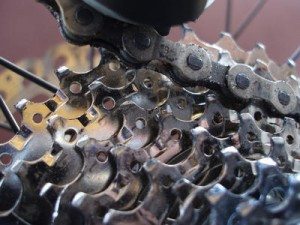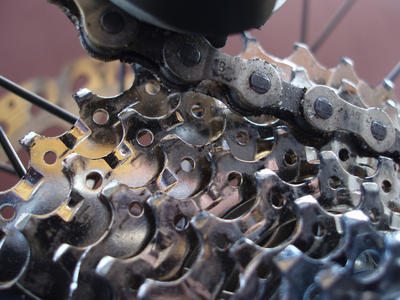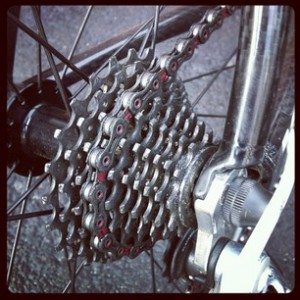While we've already dealt with choosing crankset gearing, you may still be in the dark about choosing cassette gearing. Along with your crankset gearing, that cluster of cogs on your back wheel is what will determine if you're toddling happily up the next climb or walking (and cursing) on the way up.
So how do you assure that you're not plodding when you should be pedaling? What factors go into choosing a proper cassette to match your ability and terrain?
Let's look at how to choose the proper gearing for you.
Match Your Cassette Gearing
As obvious as it seems, this should be the first consideration taken when replacing a cassette, either due to wear or as an upgrade. (As a side note, a cassette is probably one of the worst upgrades in terms of benefit per dollar spent. Most of the lower end models shift just as well and actually last much longer than the high end models, so don't think you NEED to upgrade a cassette.) Of course, the idea of replacing like with like assumes you're comfortable with the gearing you had and have no need to change to a different gearing. If you're one of the lucky few who's happy with what they have, just replace what you have with one of the same size and you'll be ready to rock and roll.
Time For Change?
If you're in the market for change, you'll need to figure out where your old gearing was lacking, and as I wrote in the choosing crankset gearing article:
“This choice almost exclusively comes down to your conditioning and the terrain you regularly ride in.”
While we were talking about crankset gearing at the time, this rings true for cassettes as well. It makes no sense to run an 11-21 cassette when you're doing 45-minute climbs, and it doesn't make much sense to run an 11-32 gearing for a flat criterium. Let's go through different situations and see what will help guide your choice.
The kind of terrain you ride is one of the biggest factors in choosing a cog set. If you're in the hills, you'll want to start with a 25t large cog and think about going larger from there. If you tend to ride longer climbs or very steep climbs, consider a 27t or 28t large cog on your cassette. For those who are doing loaded touring or just have weak climbing legs, consider a 30t or 32t large cog. The tradeoff for those reduced gear inches is a significant increase in the gaps between cogs: sometimes more than four teeth.
For flatlanders, big cogs are pretty useless. Consider a 21t cog and go up from there if you do occasionally venture into the hills. The smaller range of an 11-21 or 12-23 cassette will give you smaller jumps between gears, letting you fine tune your cadence.
Fitness
This, combined with the terrain around you are probably the biggest determinants of what gearing to bolt onto your wheel. If you're an extremely strong rider, you can get away with a smaller range of cogs, while novices or those who are early in their season may want a larger range of cogs. An 11-25 or 12-25 cog set is a perfect “all around” cassette, offering the 25t cog for moderate climbs and the 11t or 12t cog for downhill spins or fast, flat sprints. For less experienced riders, a 12-27t or 11-28t cassette is probably the better choice.
Technique
 Riding technique also plays a big part in your gear selection. Depending upon your preference to spin a little gear vs mash out a huge gear, you'll want to equip your rear wheel appropriately. Spinners will probably look for a larger cog, somewhere in the 27t range, while mashers may be perfectly happy with a 25t or 23t. Of special note for a rider who prefers to spin a gear will be the gaps between cogs; look for a cassette with a 12t or 13t small cog, which will prevent the gaps from being very large and giving you trouble in finding your sweet spot cadence.
Riding technique also plays a big part in your gear selection. Depending upon your preference to spin a little gear vs mash out a huge gear, you'll want to equip your rear wheel appropriately. Spinners will probably look for a larger cog, somewhere in the 27t range, while mashers may be perfectly happy with a 25t or 23t. Of special note for a rider who prefers to spin a gear will be the gaps between cogs; look for a cassette with a 12t or 13t small cog, which will prevent the gaps from being very large and giving you trouble in finding your sweet spot cadence.
Matching Your Cranks
So you've taken all the above into consideration and you're ready to make your decision. Hold on a second there! One last thing to consider will be the gearing you've chosen up front: after all, a 11-25t cassette may be perfect for you in all circumstances, but if you're riding a standard double (39/53t) in the steep hills, you may want to stop and consider moving to something with just a little bit more low gearing on it. Conversely, if you're riding some pretty large hills or your legs just aren't up to snuff and you've decided on an 11-28t cassette, maybe you can downsize a bit to an 11-26t if you're running mid-compact gearing (36/50t). Or if you're running a compact crank (34/50t) you might even be able to get away with a 12-25 and have some really nice, tight ratios.
My Personal Favorite Combinations
So it comes down to this: my favorite gearing combinations and my recommendations for which cassette pairs well with which chainring configuration. In the chart below, you'll find some recommended cassette options for specific crank configurations, along with the high and low gearing numbers (in gear inches, or the number of inches the bike will move forward for one pedal stroke.) By reading the chart, you can see the way changing a cassette can dramatically alter a crankset's characteristics.
| Crankset Configuration | Gears Appropriate for Climbing (Hilly Terrain) | High/Low Gear Inches (climbing) | Gears Appropriate for Flat Terrain (or Crits) | High/Low Gear Inches (flat) |
| Standard Double (39/53t) | 12-27t | 116.1/38 | 11-23t | 126.6/44.6 |
| Mid Compact Double (36/50t) | 11-26t | 119.5/36.4 | 11-21t | 119.5/45.1 |
| Compact Double (34/50t) | 12-25t | 109.5/35.7 | 11-21t | 119.5/42.5 |
If you look around the web, you'll find there is a 52t big ring option for the mid compact crank, which I didn't include in the above comparison. The reason why is that the difference in two is more or less insignificant (at that high range anyway), much like the difference between a 38t and 39t standard ring. Additionally, the concept of a 36/50t mid compact is to solve the problem of the large 16t jump between rings; adding a 52t large ring removes that advantage.
Note that I didn't include any mention of a triple in this chart, and there's a good reason for that. Triples (as I commented on in this post) are essentially a thing of the past. Not many companies make them anymore, and if you're going to see one it will likely be on a loaded touring bike that will be sporting a large “pie plate” cassette on the rear wheel.
It's also worth noting that the above combinations are only my favorite starting points. I selected them based upon the high and low ratios, the size of the steps between cogs, a 700c 23mm tire, an average length 172.5mm crank arm and based them upon a reasonably fit recreational rider. Of course, if your fitness is better or worse, you can adapt those suggestions to your situation as necessary.
If you're looking for an opinion on my favorite pieces of equipment to put on your hubs, I'm particularly fond of [easyazon_link identifier=”B002KNLX10″ locale=”US” tag=”taicoaandthed-20″]Shimano cassettes[/easyazon_link]. They seem to shift better than their SRAM counterparts from all the riding I've done. If you have Campagnolo, you're pretty much using Campy parts, so there's not much choice there anyway.
Questions? Have something to add? Don't hesitate to start the discussion.

